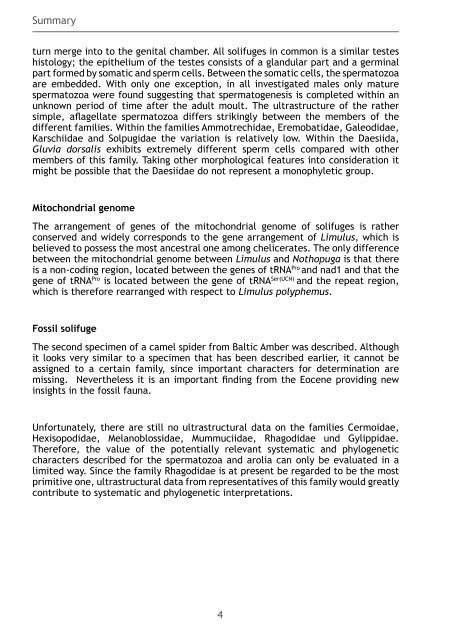HISTOLOGY AND ULTRASTRUCTURE OF SOLIFUGES ...
HISTOLOGY AND ULTRASTRUCTURE OF SOLIFUGES ...
HISTOLOGY AND ULTRASTRUCTURE OF SOLIFUGES ...
You also want an ePaper? Increase the reach of your titles
YUMPU automatically turns print PDFs into web optimized ePapers that Google loves.
Summary<br />
turn merge into to the genital chamber. All solifuges in common is a similar testes<br />
histology; the epithelium of the testes consists of a glandular part and a germinal<br />
part formed by somatic and sperm cells. Between the somatic cells, the spermatozoa<br />
are embedded. With only one exception, in all investigated males only mature<br />
spermatozoa were found suggesting that spermatogenesis is completed within an<br />
unknown period of time after the adult moult. The ultrastructure of the rather<br />
simple, aflagellate spermatozoa differs strikingly between the members of the<br />
different families. Within the families Ammotrechidae, Eremobatidae, Galeodidae,<br />
Karschiidae and Solpugidae the variation is relatively low. Within the Daesiida,<br />
Gluvia dorsalis exhibits extremely different sperm cells compared with other<br />
members of this family. Taking other morphological features into consideration it<br />
might be possible that the Daesiidae do not represent a monophyletic group.<br />
Mitochondrial genome<br />
The arrangement of genes of the mitochondrial genome of solifuges is rather<br />
conserved and widely corresponds to the gene arrangement of Limulus, which is<br />
believed to possess the most ancestral one among chelicerates. The only difference<br />
between the mitochondrial genome between Limulus and Nothopuga is that there<br />
is a non-coding region, located between the genes of tRNA Pro and nad1 and that the<br />
gene of tRNA Pro is located between the gene of tRNA Ser(UCN) and the repeat region,<br />
which is therefore rearranged with respect to Limulus polyphemus.<br />
Fossil solifuge<br />
The second specimen of a camel spider from Baltic Amber was described. Although<br />
it looks very similar to a specimen that has been described earlier, it cannot be<br />
assigned to a certain family, since important characters for determination are<br />
missing. Nevertheless it is an important finding from the Eocene providing new<br />
insights in the fossil fauna.<br />
Unfortunately, there are still no ultrastructural data on the families Cermoidae,<br />
Hexisopodidae, Melanoblossidae, Mummuciidae, Rhagodidae und Gylippidae.<br />
Therefore, the value of the potentially relevant systematic and phylogenetic<br />
characters described for the spermatozoa and arolia can only be evaluated in a<br />
limited way. Since the family Rhagodidae is at present be regarded to be the most<br />
primitive one, ultrastructural data from representatives of this family would greatly<br />
contribute to systematic and phylogenetic interpretations.<br />
4

















